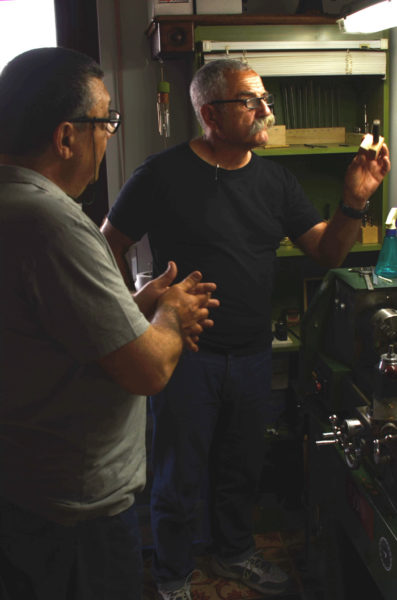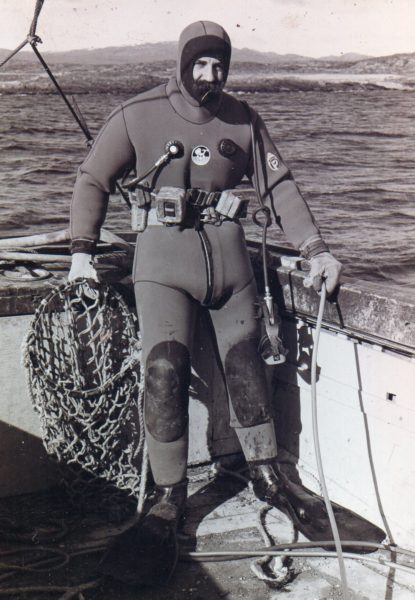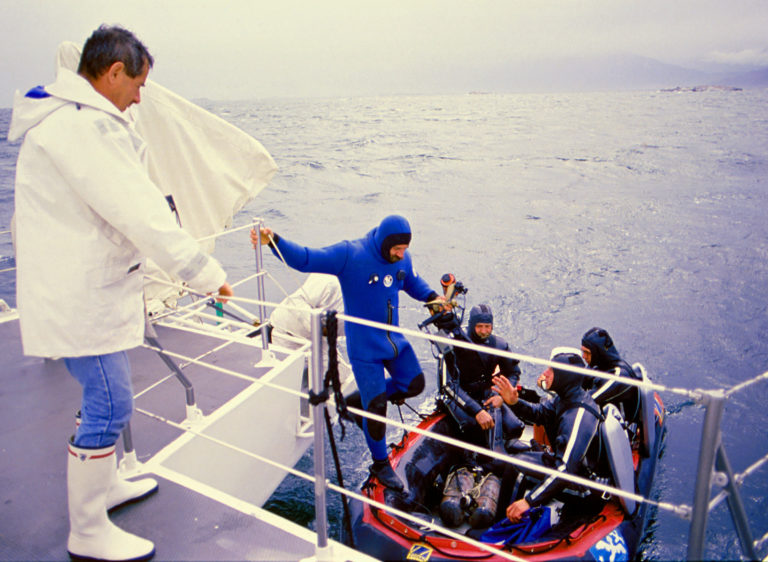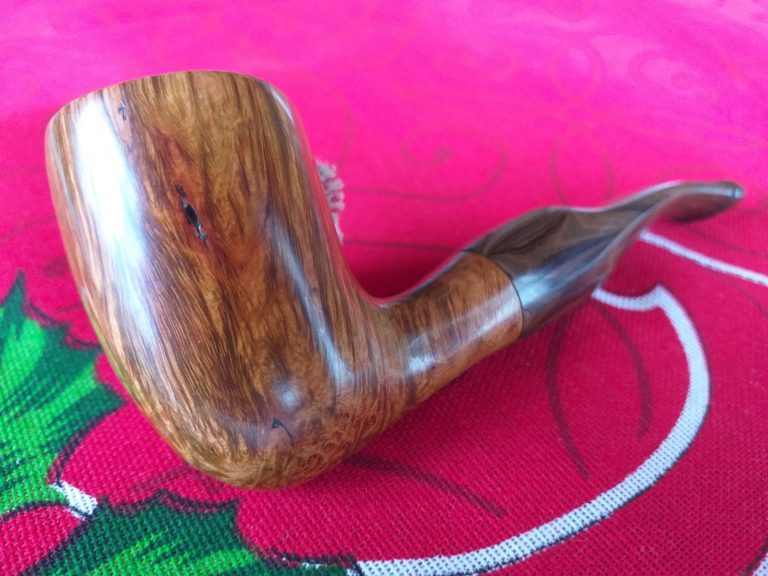
Last year (2019), on a mild June afternoon, I got a weird phone call from a woman with a strong Neapolitan accent. The lady was hosting in her B&B two people from Argentina, who wished to visit my craft workshop. These two were unable to contact me via WhatsApp and had asked her if I could. She gave me their number and I contacted them. They were Hector and Mariano Monsalve, father and son, on their holiday in Sicily from the far Ushuaia, in the extreme south of Patagonia. I had been in Ushuaia several years before and the idea that someone living there would want to talk about pipes right with me, living halfway around the world, seemed so unreal to me that it looked even funny.
Some days after, Hector and Mariano arrived in Palermo on a terribly hot afternoon for them (27°C). It was midwinter in their homeland and no more than 5°C. Hector had a nice moustache and athletic build, although he was long over 60, his son Mariano was a very friendly big guy and ready to joke. Hector is fond of pipes and, since there’s no briar in Patagonia and delivery is quite expensive, he makes his pipes with the wood of a Chilean shrub we weren’t able to give a botanical name. As I always do, when someone wants to learn the basics of making a pipe, I begin to work at one, starting from the briar up to the stem. Of course, I don’t finish it, because I like to leave this task to the one who has, so far, just watched.

Until now, about where they came from, nothing strange. It was when we started talking about our lives, that the treasure they were carrying with them came up. During dinner, in front of some fried squids, Hector told me about his life and I got charmed. Hector has been a professional diver, photographer, fisherman and …Jacques Cousteau’s guide. Today he’s running a family business in Ushuaia dealing with marine adventure tourism. All at once, his hieratic, good-natured figure acquired meaning. This is what intrigued me about him, I had grasped that he wasn’t an ordinary person but a man from another era. Now I was eager to know as much as possible about his life and he didn’t refuse. But I prefer to let him tell you about himself, translating some parts of an interview.
(…) I must stress that I didn’t become a diver because of Cousteau; my enthusiasm started with a TV show which, in 1958/59, Channel 7 broadcasted in Buenos Aires: “ Caza submarina” (Underwater Home), also called “ El investigador submarino”(The Underwater Detective), with the American actor Lloyd Bridges performing. On some afternoon, at milk time after school, we would watch that program on the old TV my grandma Casilda had handed over to us. Our house was one at the corner of Calle Aslina Catamarca, in the very centre of Once district. There wasn’t actually just Lloyd Bridge: we used to gather with some friends of the neighbourhood to follow the adventures of Mike Nelson, a definitely heroic diver who let our imagination run wild. Furthermore, the bookshelves of my old man enhanced my imagination. “Tesoro de la juventud” (Tresure of the Young) and its teachings, and above all one of the fantastic illustrations, something like: “Mamiferos de Sudamerica” (South American Mammals), and that particular book with paintings of whales and dolphins swimming in the cold water of the south. During weekends I would go to “Zio Paco’s” (Uncle Paco) swimming pool, a great uncle, a world of fins, snorkels and “Plaf” masks, trying to emulate our heroes’ lungs and submarine movements…imagining to be under the sea. The scars of the sores that blessed fins left on my feet !!!!! Saying I almost slept with them is no exaggeration. Years went by, I was growing and I can say that at that point I was quite good, thanks to my hours at “Zio Paco’s” pool, at using the equipment, also because it wasn’t of “Plaf” brand anymore nor that simple. I had now a “Mares” mask with snorkel and fins, coming from Europe, a real luxury to us.
Several years later, it was 1965 and I was at my second year in Schule Cangallo High School, during geography class Mrs Conte, our teacher, gave us the weekend homework: Reading some pages from the book”El mar viviente” (The Living Sea), the second one written by Jacques Cousteau. If it was a difficult task for my classmates, it was a more than obvious result to me: I didn’t just read the book but I went on with the first one Cousteau had published: “El mundo del silenzio” (The World of Silence). That same year my dear friend and classmate Horatio Berisso had already started to teach me some basics about photo shoots and techniques in the darkroom. His father, doctor Horatio Berisso, a bio-chemist, was an eminent photographer and researcher, who had been, since 1910, a photography pioneer in Argentina. It was him who passed on to me the passion for this activity. Even now, every time I dive to take pictures, Horatio, gone too soon, and his father are always with me, wherever they may be. In my memories of that time I see myself as a cute teenager, walking along Viamonte street, going to Enrique Alvarez’s “Subacuo”, an old shop which used to sell diving equipment, some old regulators, oxygen tanks made from adapted fire-extinguishers, harpoons… But there was something there that captured my attention: a waterproof camera case. It had a gross, square shape, obviously homemade with plexiglass, and contained a 6 X 6 camera and two lenses like a Rolleiflex. I think it was a Zenit.
In those years immersions in Argentina were practiced by very few amateurs or Navy divers. For this reason it wasn’t easy to find an instructor. During one of my recurrent visit at “Subacuo”, while trying to sneak into the diving world, I found out about the CUBA (University Club Buenos Aires), which was giving immersion classes. It was one of the pioneer diving clubs in the country that was a member of ASES (Agrupación Subatlántica de Expediciones Submarinas/ Subatlantic Group for Submarine Expeditions). I remember having taken a registration request at the ASES headquarters, I believe it was in Via Lavalle. I discovered ,to my utmost horror, I was too young and would have needed my father’s approval. Scared as I was, I talked to him about it, but no luck. His laconic answer still stings my mind: “That’s a job for lunatics and drunkards!”… Over time I learned he wasn’t completely wrong, after all, my father was a visionary! I didn’t actually want to make a job of it at the time, but I can grant you my father was relentless in his decisions. Anyway, in the meantime my equipment had evolved with a “Pinocchio” mask and Rondine by Cressi fins from Italy and I trained with immersions in the pool and in apnea. Then, in February 1970, my father suggested me to go and visit my uncles in Valencia, Venezuela, where they had settled for some years. I accepted immediately! I knew that my dear uncle Leo had a boat and I couldn’t miss the opportunity to know the Caribbean!!! I went there with fins, mask and snorkel. I couldn’t imagine that travel would have changed my life… We spent a few days of the holiday at Alfredo Domingo and his family’s, my uncles’ friends, on the island of Cayo Sal, near Morrocoy, in the State of Falco. I remember my happiness while I spent entire days snorkelling in the Cayo surroundings, the transparency of the water was incredible and lifestyles so peculiar and varying. On one of those lazy afternoons, after dinner, while walking around the place, I discovered in a small boathouse two regulators hanging on a wall, some diving tanks with strap harnesses and a little air compressor. The son of the owner saw me poking around and came closer. I asked him if those “things” worked. He answered they were his father’s, from the days of his diving. I asked if his father would let me dive with him: “Sure, he will love it!” he replied. That same afternoon we filled with air a pair of tanks. I was excited and impatient, during my pool days I had tried to breathe underwater using long pipes, forge bellows, inflators an even air bags.
After that unforgettable baptism, I joined the CASBA (Centro de Actividades SubacuáticasBuenos Aires /Submarine Activities Centre Buenos Aires) and continued my training in Patagonia with courses and travels. (…) In October 1974, with some friends from CASBA and people from ASES, I went to Puero Madryn to face the theoretical-practical exam. The great “Pino” Nicoletti was at the head of the examining Committee and he signed, to my great pride, my brand new qualification as National Diving Instructor. Some years later I got married and became a professional diver.

I lived in Venezuela for a while but, in 1976 I moved to Ushuaia. I have made of this my way of living and of underwater photography my passion. Leon Gieco wrote: “Life is made of open circles that, at a point, close and turn full”. One of my circle opened when the geography teacher made us read “The Living Sea” of Cousteau and it closed almost completely when in December 1985 I was Jacques Cousteau’s diving guide on his then-new boat “Alcyone” in the Beagle Channel. It’s been twenty years since that reading which had “enlightened” me. And when I met “old” Cousteau, I should have reproached him, because he didn’t want to have a picture taken with me. I didn’t know it was what he hated most… I would have liked to show it to my grandchildren, that’s why that circle hasn’t closed completely. But others will open and many other are still to be closed, if the “bearded guy” upon us wants to.

Since 1976 Hector worked 15 years as mussels and shrimps fisher in Canal Beagle, discovering thus a huge variety of seabed that has pushed him to collect information and study the local fauna. His innate curiosity, together with the acquaintance of some biologists and naturalists have led him to become a successful professional diving photographer. He has cooperated as a diving guide with several international TV channels (NDR, ZDF, Von Reisen, TV Tokyo, TVF and M6, Natural History Museum, National Geographic and Discovery Channel). In 1995 he was awarded by INCAA (Argentina Visual Arts and Cinema National Institute) for the production of the documentary “Nuestra Argentina Submarina” ( Our Underwater Argentina), which was broadcasted by the educational Iberian-American TV.
In 2008, with biologist Pablo Enrique Penchaszadeh, he published the first book of scientific underwater photography in Argentina: “Patagonia Submarina”. Hector has discovered the remains of the Monte Cervantes, a 160 meters vessel that made the route Buenos Aires – Puerto Madryn (Chubut) – Punta Arenas (Chile) – Ushuaia – Buenos Aires, flying the German flag, that had disappeared in 1930 with 1200 passengers on board. In the same way he found at a depth of 30 meters what was left of the “pájaro naranja”, a plane of the Fuegian Government that had an accident in 1984, while flying governor Ramón Albero, his wife and ten of his staff people. His productions are used by educators all over the country and as scientific divulgation material.
You can currently find Hector and Mariano in Ushuaia, where he owns a micro family-run business dealing with “adventure tourism”, whose name, “Tres Marìas”, comes from a 9 meters boat that pioneered in Ushuaia 21 years ago. The Tres Marìas is still sailing but others have joined it: the sailing boat “If”, an amazing French-built 14 meters boat and the 13,8 meters luxury yacht “Sea Gold”. (https://www.tresmariasweb.com).
I can’t conclude this tribute to an extraordinary man without showing the reason of his visit in my lab. Hector has finished our pipe in Ushuaia and, objectively, I have to say the result isn’t actually so brilliant. But this is one of those cases where you don’t mind the result but the road you have walked to reach it.

Thanks Hector, thanks Mariano. See you in Ushuaia.




